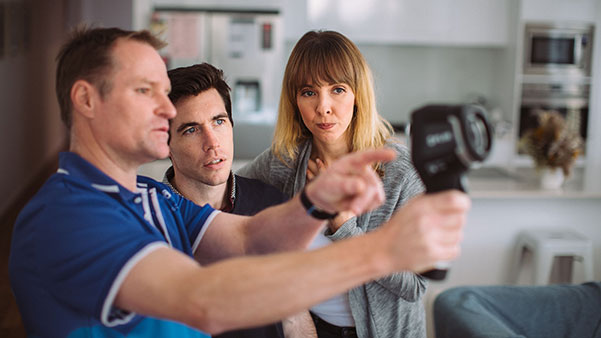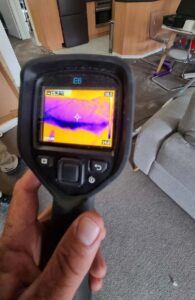How Thermal Imaging Helps in Water Damage Restoration
When it comes to water damage restoration, one of the biggest challenges is finding hidden moisture. Water can seep into places you’d never expect, and not all of it is visible to the naked eye. That’s where thermal imaging technology comes in.
Thermal imaging cameras allow restoration specialists to quickly and accurately detect areas affected by water—even when surfaces look completely dry. This ensures that no hidden moisture is missed, reducing the risk of mould growth, structural damage, and costly repairs down the track.
Why Thermal Imaging is Essential in Water Damage Jobs
Without the right tools, it’s impossible to know the true extent of water damage inside a property. Thermal imaging provides a clear picture of where moisture has spread, helping experts plan the best course of action for drying and restoration.
This advanced technology can identify moisture in:
-
Wet gyprock walls and concealed wall cavities
-
Carpets, tiles, and flooring of all types
-
Ceilings and roof cavities
-
Cabinetry and built-in furniture
-
Wall and ceiling insulation
-
Floating floors and concrete slabs
-
Timber flooring, frames, and sub-floors
By pinpointing every area affected, thermal imaging makes restoration faster, more effective, and far more reliable.
If your home or business has suffered water damage, using thermal imaging for moisture detection ensures that nothing is overlooked. At Flood Fixers, we use the latest equipment to accurately locate hidden water, so we can dry, restore, and protect your property the right way the first time.
Thermal Imaging for Moisture Mapping
In the water damage restoration industry, moisture mapping is one of the most important steps in identifying exactly where water has spread throughout a property. To do this accurately and efficiently, many professional restorers use thermal imaging technology.
Thermal imaging allows experts to clearly outline the affected areas and determine which parts of the building need structural drying. It can even indicate the level of moisture present in different materials, helping to create a precise plan for restoration.
Because it delivers instant results, thermal imaging is particularly valuable when working on large water damaged properties. The data and images captured can also be stored and integrated into detailed reporting systems, making it easier to track progress and provide evidence for insurance claims.
Key benefits include:
-
Fast and accurate identification of moisture-affected areas
-
Clear indication of how much moisture is present
-
Efficient mapping of large-scale damage
-
Easy integration into restoration reporting systems
Thermal Imaging for Water Damage Assessments
Thermal imaging is also widely used during water damage assessments. In many cases, moisture is hidden inside walls, ceilings, or beneath flooring, making it impossible to see with the naked eye. Thermal cameras detect these concealed areas of damage quickly, giving a full picture of the situation.
This technology is not only helpful for restorers but also provides clear visual proof for property owners. Customers are often surprised when shown just how far water has travelled beyond what is visible on the surface.
By locating even the smallest traces of trapped moisture, thermal imaging ensures that no affected areas are overlooked. This is vital for preventing long-term problems such as mould growth, weakened structures, and recurring water damage.
Thermal imaging has become an essential tool in modern water damage restoration. Whether for moisture mapping or full assessments, it allows professionals to detect hidden water, plan accurate drying strategies, and give property owners complete transparency about the extent of the damage
Thermal Imaging for Leak Detection
While thermal imaging is not a dedicated leak detection device, it can be an extremely valuable tool when used correctly. In water-damaged homes and commercial properties, leaks often start inside wall cavities or beneath floors, making them very difficult to pinpoint.
A thermal imaging camera helps technicians identify moisture hotspots that suggest the likely source of a leak. By highlighting areas of temperature difference, the camera provides a clear indication of where water is entering the structure.
In many cases, thermal imaging can also trace the path that moisture has taken as it spreads through walls, ceilings, or flooring. This hidden water is impossible to detect with the naked eye, but thermal technology makes it visible and trackable.
Why Thermal Imaging is a Key Tool in Water Damage Restoration
For professional restorers, a high-quality thermal imaging camera is one of the most important tools on the job. By using this technology, they can confidently locate moisture, confirm the extent of water damage, and create a more effective restoration plan.
Thermal imaging is used across a wide range of restoration services, including:
-
Moisture mapping of residential and commercial properties
-
Evaluating flooded houses and buildings
-
Carrying out detailed water damage assessments
-
Supporting mould remediation inspections
-
Detecting trapped or hidden moisture inside structures
-
Measuring moisture levels in walls, ceilings, and floors
-
Assessing water damage in commercial properties
-
Assisting with leak location and tracking
Thermal imaging may not replace specialised leak detection tools, but when it comes to identifying and tracking moisture, it is an essential part of the water damage restoration process. By helping restorers find hidden leaks, map out water migration, and document damage, thermal cameras play a vital role in delivering accurate and effective restoration results.
Flood Fixers – Advanced Thermal Imaging for Water Damage Restoration on the Gold Coast
At Flood Fixers, our technicians are fully trained and accredited in the latest thermal imaging techniques. By using state-of-the-art equipment, we can accurately detect and locate even the smallest traces of hidden moisture inside water damaged homes and businesses across the Gold Coast.
Thermal imaging allows us to go beyond surface inspections. Whether it’s inside wall cavities, under flooring, or within ceilings, our technology ensures no trapped water is left untreated. This precision is key to preventing long-term damage such as mould growth, weakened structures, or recurring dampness.
How We Use Thermal Imaging in Restoration
Our team applies advanced thermal imaging for a variety of restoration tasks, including:
-
Moisture mapping of residential and commercial buildings
-
Comprehensive water damage assessments for Gold Coast homes
-
Tracking leaks and locating hidden moisture pathways
-
Flooded property evaluations after storms or burst pipes
-
Accurate moisture readings to guide structural drying plans
By combining expertise with the latest technology, Flood Fixers delivers faster, more effective restoration results that give property owners peace of mind.
Available 24/7 for Water Damage Emergencies
We know that flooding and water damage can strike at any time. That’s why our team is available around the clock, ready to respond to water damage emergencies anywhere on the Gold Coast. Whether you need urgent water extraction, detailed moisture mapping, or professional thermal imaging services, Flood Fixers is here to help.
If you’re dealing with a water damage emergency and need advice or immediate assistance, don’t hesitate to contact us. We’re always happy to provide guidance and support when you need it most.
Flood Fixers Gold Coast water damage service areas include:
Servicing all Gold Coast suburbs Including
Southport, Surfers Paradise, Broadbeach, Burleigh Heads, Palm Beach, Coolangatta, Currumbin, Miami, Robina, Varsity Lakes, Mermaid Beach, Mermaid Waters, Nerang, Ashmore, Helensvale, Labrador, Runaway Bay, Hope Island
Servicing all Gold Coast Suburbs and areas with our 24/7 rapid response service.




